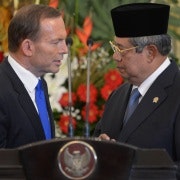BUDGET 2013: The slow road to the black
What is almost certainly the Gillard government's last budget delays the attack on the deficit and concentrates on entrenching “legacy” programs, for which Labor hopes to be remembered.
Dealt a difficult hand in revenue write-downs and a continuing high dollar, the budget expects virtually no improvement in the bottom line between this financial year and next.
What was supposed to be a surplus in 2012-13 is expected to be a deficit of AU$19.4 billion – with a A$18 billion deficit to follow in 2013-14.
Burnt by previous unequivocal and upbeat projections, Treasurer Wayne Swan spoke of “a responsible pathway back to balance in 2015-16” – when the budget is projected to be in the black by A$800 million – followed by a surplus by 2016-17 (A$6.6 billion).
After the previous record, who knows whether these figures will be anything near the mark.
The savings are limited in the early period – around $2 billion in 2013-14. But they build up in the later years of the budget period to about A$16 billion in 2016-17, and a total of about A$43 billion over the whole forward estimates.
There was a note of defensiveness in the Treasurer's speech, anticipating those who would say that much more effort should have been made to tackle the deficit faster.
“Just because the global economy took an axe to our budget, does not mean we should take an axe to our economy,” he said.
“Just as we shielded Australia from the worst during the GFC, we will continue to follow the responsible middle course,” he said. “Because of our deep commitment to jobs and growth we have taken the responsible course to delay the return to surplus … The alternative, cutting to the bone, puts Australian jobs and our economy at risk.”

The political debate will now become whether an Abbott government would seek to move faster to surplus, with tougher short-term cuts.
On the spending side, the centrepieces of the budget are the Gonski school funding program and the disability insurance scheme, as well as infrastructure, road and rail projects.
The education and disability initiatives are social reforms which the government is trying to entrench. It should be successful with disability, because it has all states except Western Australia signed up and the scheme has bipartisan support, including to an increase in the Medicare levy.
The Gonski funding is another matter. It hangs in the balance because it is not clear how many states will sign up or what a coalition government would do with the outcome it had inherited.
The multi-billion dollar infrastructure spending is directed to a range of road and rail projects and tied into the themes of improving productivity and creating jobs.
On the savings side, the government has continued pruning “middle class entitlements” and finally confronted the expensive Baby Bonus. This would be abolished from next year with the Family Tax Benefit-A being increased for newborns.
The “pause” in the indexation for family payments for the upper income levels under the system is also being extended. (These measures are in addition to the earlier announced cancellation of an increase due this year to the Family Tax Benefit.)
The budget night changes are sensible and will be another test for the opposition. Shadow treasurer Joe Hockey has frequently criticised the “entitlement” mentality. If the opposition attacks these measures, it will be an exercise in hypocrisy. If it goes along with them, some useful savings work will have been done for it if it becomes the government.
Faced with escalating health costs the government is also making several savings in the health area, including changes to the timing of the indexation of the Medicare benefits schedule.
The government will close various corporate tax loopholes, yielding several billion dollars over the forward estimates, but business has not been hit with major new tax imposts.
The mining tax is performing even worse than expected with an estimate that it will yielding only about $200 million in 2012-13 although it is estimated to rise than more than $2.2 billion in 2016-17. If there's an Abbott government we'll never know whether this is an heroic assumption.
The budget is where reality has hit the government's climate change program. It dramatically revises down the carbon price for 2015, when the trading scheme begins, to around $12 a tonne. The proposed 2015 tax cuts have been deferred – as announced before the budget – “until the carbon price is estimated to be above $25.40. This is currently projected to occur in 2018-19.”
Nobody should expect these tax cuts are being anything but scrapped forever.
The picture Swan presents is one of the relatively strong economic outlook for Australia. Growth next financial year is forecast to be 2.75% rising to 3% – on trend – in 2014-15. The unemployment rate is forecast to rise a little – from 5.5% this year to 5.75% next financial year.
While the government has made some economic mistakes, and would be in a much better position if it has wound back spending faster after the huge stimulus injection, it is also true that circumstances have been against it. There is a big contrast between the world that former treasurer Peter Costello faced in his latter budgets and that faced by Swan.
For all the problems that beset the government, the Australian economy has done and is still doing well, in comparison with other advanced economies.

Michelle Grattan does not work for, consult to, own shares in or receive funding from any company or organisation that would benefit from this article, and has no relevant affiliations.
This article was originally published at The Conversation. Read the original article.













